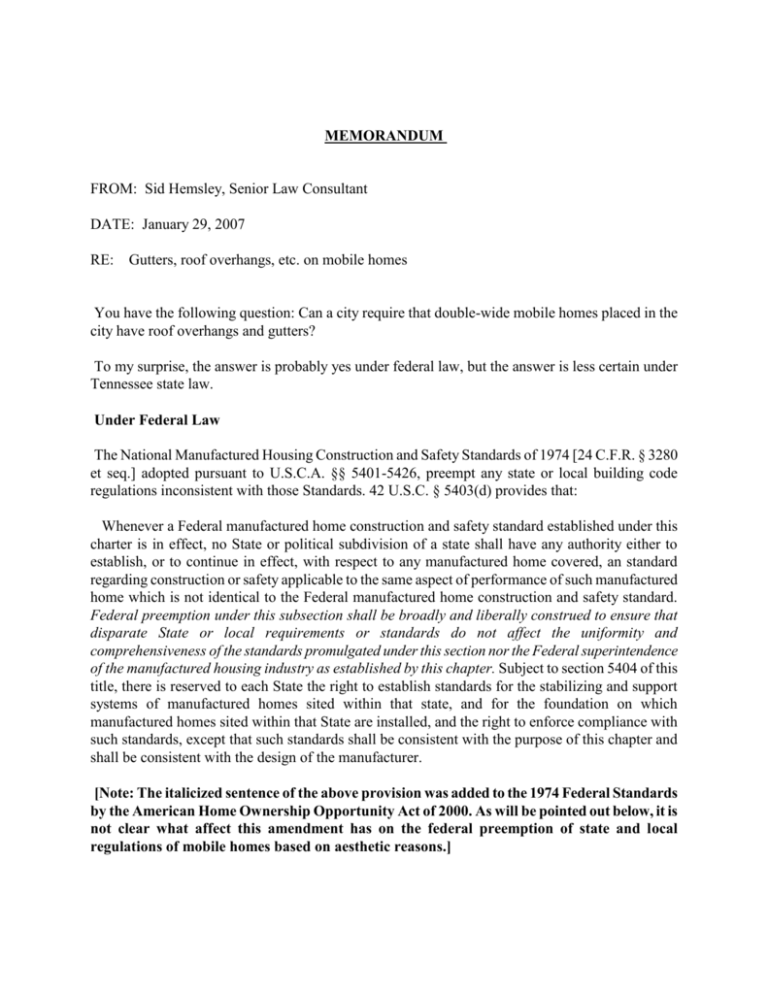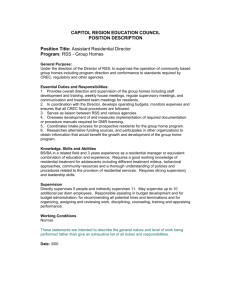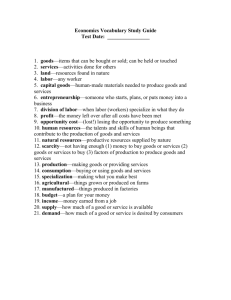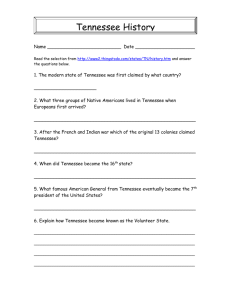Regulating Exterior Appearance of Mobile Homes public
advertisement

MEMORANDUM FROM: Sid Hemsley, Senior Law Consultant DATE: January 29, 2007 RE: Gutters, roof overhangs, etc. on mobile homes You have the following question: Can a city require that double-wide mobile homes placed in the city have roof overhangs and gutters? To my surprise, the answer is probably yes under federal law, but the answer is less certain under Tennessee state law. Under Federal Law The National Manufactured Housing Construction and Safety Standards of 1974 [24 C.F.R. § 3280 et seq.] adopted pursuant to U.S.C.A. §§ 5401-5426, preempt any state or local building code regulations inconsistent with those Standards. 42 U.S.C. § 5403(d) provides that: Whenever a Federal manufactured home construction and safety standard established under this charter is in effect, no State or political subdivision of a state shall have any authority either to establish, or to continue in effect, with respect to any manufactured home covered, an standard regarding construction or safety applicable to the same aspect of performance of such manufactured home which is not identical to the Federal manufactured home construction and safety standard. Federal preemption under this subsection shall be broadly and liberally construed to ensure that disparate State or local requirements or standards do not affect the uniformity and comprehensiveness of the standards promulgated under this section nor the Federal superintendence of the manufactured housing industry as established by this chapter. Subject to section 5404 of this title, there is reserved to each State the right to establish standards for the stabilizing and support systems of manufactured homes sited within that state, and for the foundation on which manufactured homes sited within that State are installed, and the right to enforce compliance with such standards, except that such standards shall be consistent with the purpose of this chapter and shall be consistent with the design of the manufacturer. [Note: The italicized sentence of the above provision was added to the 1974 Federal Standards by the American Home Ownership Opportunity Act of 2000. As will be pointed out below, it is not clear what affect this amendment has on the federal preemption of state and local regulations of mobile homes based on aesthetic reasons.] The 1974 Federal Standards have been held to preempt building code requirements that conflict with those requirements. [See Scurlock v. City of Lynn Haven, 858 F.2d 1521 (11th Cir. 1988); Texas Manufactured Housing Association, Inc. v. City of Nederland, 1203 F.3d 1095 (5th Cir. 1996); Colorado Manufactured Housing Association v. Board of County Commissioners of County of Pueblo, 946 F.Supp. 1539 (Colo. 1996).] A local ordinance that regulated roof strength requirements was held invalid as conflicting with the 1974 Federal Standards in Michigan in Manufactured Housing Association v. Robinson Township, 73 F. Supp.2d 823 (W.D.Mich. 1999).] But several cases have held that zoning regulations, including roof regulations, that have an aesthetic, rather than a consumer protection, purpose are not preempted by the 1974 Federal Standards, even when they require construction modification/s to mobile homes. The lead case in this area is Georgia Manufactured Housing Association Inc. v. Spalding County, 148 F.3d 1304 (11th Cir. 1998). There the Court upheld the county’s zoning regulation that permitted mobile homes in residential zones only if they had a roof with a 4:12 pitch, on the grounds that the 1974 Federal Standards were designed to protect consumers from mobile home hazards, and that the 4:12 roof pitch requirement “does not have any purported basis in consumer protection, but is a straight forward declaration that the County does not want low-pitched roofs in its residential areas.” [At 1310] A county zoning ordinance that required mobile homes placed in certain locations to have siding and roof shingles of a type “commonly used in residential construction,” and a roof pitch of 21/2 feet for each 12 feet of horizontal run, was upheld in CHM Manufacturing, Inc. v. Catawba County, 994 F.Supp. 697 (W.D.N.C. 1988). Those standards went to appearance, not to safety, reasoned the Court. My review of the current 1974 Federal Standards do not reveal any regulations pertaining to roof overhangs (only to roof loads and coverings) and gutters. For that reason, presumably regulations in those areas would survive a challenge that they conflict with those Standards. In fact, it appears that if a local government can justify a particular mobile home regulation on any grounds other than safety and consumer protection, the regulation might survive a challenge that it violates the 1974 Federal Standards. But as far as I can determine, no federal or state case have yet considered what effect, if any, the 2000 amendment to the 1974 Federal Standards noted above have on mobile home standards adopted by state and local government based on aesthetic or other purposes. Presumably that amendment reflects a response to some of the cases that permit state and local governments to do an end run around those Standards on aesthetic grounds. But even if that is true, the language of that amendment does not appear to expand the purposes of the 1974 Federal Standards beyond its safety and consumer protection purposes. Under Tennessee Law Aesthetically-based double-wide mobile home regulations that might survive the 1974 Federal Standards, might not survive Tennessee law on the subject, especially with respect to double-wide mobile homes in residential areas. In Tennessee local governments attempting to impose appearance standards of any kind on doublewide mobile homes in residential areas must deal with Tennessee Code Annotated, § 13-24-201– 202, and with the case law on the subject of zoning for aesthetic purposes. Tennessee Code Annotated, § 13-24-201 preempts the right of local governments “to exclude the placement of a residential dwelling [double-wide manufactured home] on land designated for residential use solely because the dwelling is partially or completely constructed in a manufacturing facility.” However, Tennessee Code Annotated, § 13-24-202 provides that “Such manufactured residential dwelling shall have the same general appearance as required for site-built homes.” There are no cases interpreting that standard, but on its face that standard it may hurt more than help cities in the regulation of double-wide mobile homes in residential areas. The regulations upheld in the above cases deal with roof pitch, shingles and siding. Mobile home manufacturers may have a strong argument that the phrase “the same general appearance as required for site built homes,” is broad, and does not allow a city to dictate exquisite construction particulars such as roof pitch, overhangs, shingles and siding, and by analogy, other similar appearance regulations. With particular respect to gutters, it can be argued that gutter requirements have no aesthetic purpose whatsoever. It probably does not go too far to say that houses probably look better without gutters and down spouts. But as pointed out above, gutter regulations do not appear to conflict with the 1974 Federal Standards, and can probably be justified under state law on any number of grounds other than aesthetic ones. The State of Tennessee has adopted the Uniform Standards for Manufactured Homes Act, codified in Tennessee Code Annotated, § 68-126-1011, which is the vehicle by which the Tennessee State Department of Commerce and Insurance enforces the 1974 Federal Standards. Tennessee Code Annotated, § 68-126-203 states the purpose of the Tennessee Uniform Standards for Manufactured Homes, which is obviously similar to the policy stated in the 1974 Federal Standards: Manufactured homes, like other finished products having concealed vital parts, may present hazards to the health, life and safety of persons and to the safety of property unless properly manufactured. In the sale or rental of manufactured homes, there is also the possibility of defects not readily ascertainable when inspected by purchasers. It is the policy and purpose of this state to provide protection to the public against those possible hazards, and for that purpose to forbid the manufacture and sale or lease of manufactured homes that are not so constructed and to provide reasonable safety and protection to their owners and users. The focus of the Tennessee Uniform Standards appears to be the same as the 1974 Federal Standards: safety and consumer protection. There appears to be nothing in the Tennessee Uniform Standards that would intercept local zoning regulations that have an aesthetic purpose. But here I point again to the Tennessee Code Annotated, § 13-24-202 which appears to state a broad standard for what appearance a double-wide mobile home must present in a residential area: “the same general appearance as required for site built homes.” . Finally, Norris v. Bradford, 321 S.W.2d543 (1958), held that zoning ordinances passed solely for aesthetic purposes are invalid. That case may not survive a challenge in this day and time in which aesthetics are far more important than they used to be, but until it is overturned or modified, that case is still a problem for local government zoning regulations based on aesthetics.





